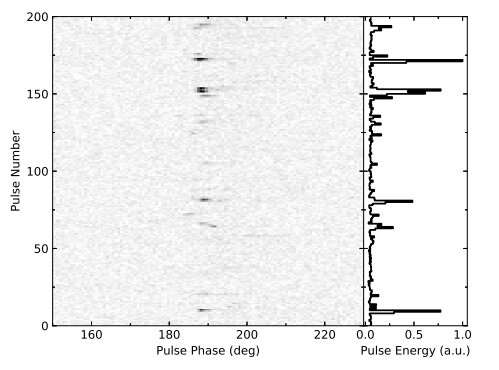A single-pulse stack of 200 successive pulses for PSR J1047−6709. The right panel shows the pulse energy variations for the pulse sequence. Credit: Sun et al., 2020.
Using the Parkes radio telescope, Chinese astronomers have investigated an isolated pulsar known as PSR J1047−6709 and detected dozens of giant pulses during the bright state of this source. The finding is reported in a paper published December 10 on the arXiv pre-print repository.
Pulsars are highly magnetized, rotating neutron stars emitting a beam of electromagnetic radiation. They are usually detected in the form of short bursts of radio emission, however, some of them are also observed using optical, X-ray and gamma-ray telescopes. To date, most pulsars have been discovered using the Parkes Observatory in Australia.
Some pulsars showcase the so-called giant pulses (GPs)—short-duration, burst-like radio emissions from a pulsar, with energies exceeding the average pulse energy by 10 times or even much more. So far, such activity has only been detected in 16 pulsars.
Now, a team of astronomers led by S. N. Sun of the Xinjiang Astronomical Observatory in China, reports the finding of another addition to this short list. By analyzing the data from observations of the PSR J1047−6709 pulsar by the Parkes 64-meter radio telescope at 1,369 MHz, they discovered 75 GPs from this source. PSR J1047−6709 is an isolated pulsar with a spin period of 0.19 seconds and magnetic field strength at the light cylinder of some 702 G.
"In this paper, we present the first detection of GPs in this pulsar using the Parkes 64-m radio telescope," the researchers wrote in the study.
First, the astronomers found that PSR J1047−6709 switches between weak and bright emission states. They assume that this state switching is most likely related to the variations of the current in the magnetospheric field of this pulsar.
The study identified 75 GPs during the bright state of PSR J1047−670, whose energies are about 10 times larger than the average pulse energy. The brightest GP has a peak flux density at a level of approximately 19 Jy, which is 110 times higher than the peak flux density of the mean pulse profile. In general, the detected GPs have pulse widths ranging from 0.6 to 2.6 ms.
Although more high time-resolution observations are needed to understand the nature of GPs reported in the paper, the astronomers noted that their study provides important information that could shed more light on the origin of such phenomena in pulsars.
"We also compared the polarization properties of the GPs to those pulses in the bright state with the pulse energy less than 10 times the average pulse energy. (...) Although the GP profile is relatively narrow, they have similar profile shapes. (...) These similarities suggest that the emission mechanism is basically the same for GPs and the pulses in bright state with energy less than 10 times average pulse energy, which supports the idea that GPs are generated in the polar gap region for this pulsar," the authors concluded.
More information: Detection of giant pulses in PSR J1047−6709, arXiv:2012.05482 [astro-ph.HE] arxiv.org/abs/2012.05482
© 2020 Science X Network
























